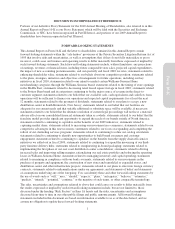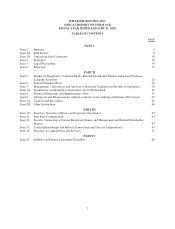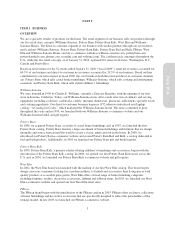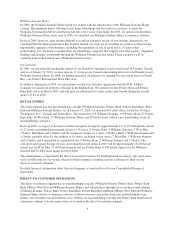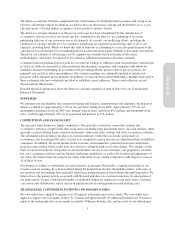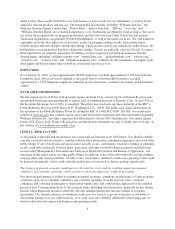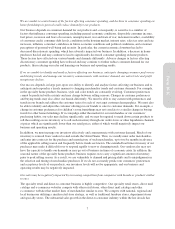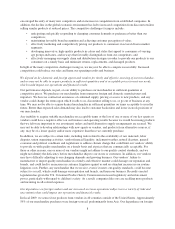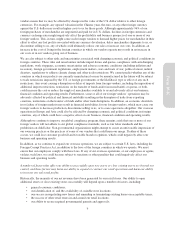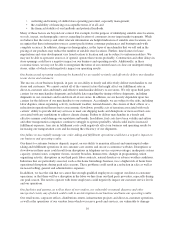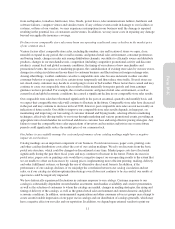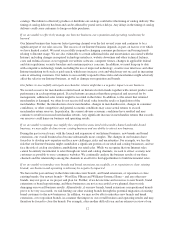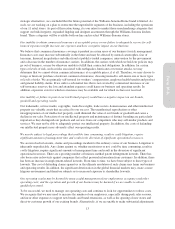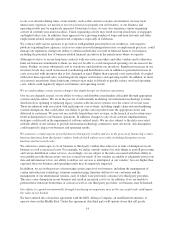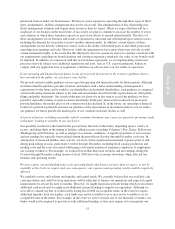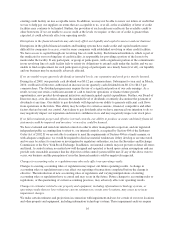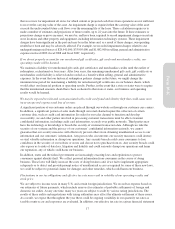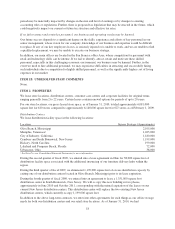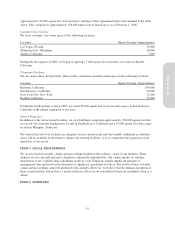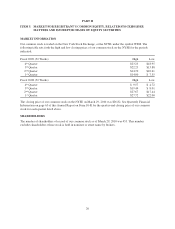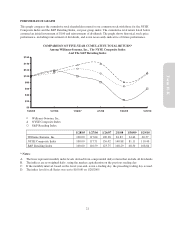Pottery Barn 2009 Annual Report Download - page 23
Download and view the complete annual report
Please find page 23 of the 2009 Pottery Barn annual report below. You can navigate through the pages in the report by either clicking on the pages listed below, or by using the keyword search tool below to find specific information within the annual report.
from earthquakes, tornadoes, hurricanes, fires, floods, power losses, telecommunications failures, hardware and
software failures, computer viruses and similar events. If any of these events result in damage to our facilities or
systems, or those of our vendors, we may experience interruptions in our business until the damage is repaired,
resulting in the potential loss of customers and revenues. In addition, we may incur costs in repairing any damage
beyond our applicable insurance coverage.
Declines in our comparable store sales may harm our operating results and cause a decline in the market price
of our common stock.
Various factors affect comparable store sales, including the number, size and location of stores we open, close,
remodel or expand in any period, the overall economic and general retail sales environment, consumer preferences
and buying trends, changes in sales mix among distribution channels, our ability to efficiently source and distribute
products, changes in our merchandise mix, competition (including competitive promotional activity and discount
retailers), current local and global economic conditions, the timing of our releases of new merchandise and
promotional events, the success of marketing programs, the cannibalization of existing store sales by our new stores,
changes in catalog circulation and in our direct-to-customer business and fluctuations in foreign exchange rates.
Among other things, weather conditions can affect comparable store sales because inclement weather can alter
consumer behavior or require us to close certain stores temporarily and thus reduce store traffic. Even if stores are
not closed, many customers may decide to avoid going to stores in bad weather. These factors have caused and may
continue to cause our comparable store sales results to differ materially from prior periods and from earnings
guidance we have provided. For example, the overall economic and general retail sales environment, as well as
current local and global economic conditions, has caused a significant decline in our comparable store sales results.
Our comparable store sales have fluctuated significantly in the past on an annual, quarterly and monthly basis, and
we expect that comparable store sales will continue to fluctuate in the future. Comparable store sales have decreased
in the past and may continue to decrease in fiscal 2010, however, past comparable store sales are not necessarily an
indication of future results. Our ability to improve our comparable store sales results depends, in large part, on
maintaining and improving our forecasting of customer demand and buying trends, selecting effective marketing
techniques, effectively driving traffic to our stores through marketing and various promotional events, providing an
appropriate mix of merchandise for our broad and diverse customer base and using effective pricing strategies. Any
failure to meet the comparable store sales expectations of investors and securities analysts in one or more future
periods could significantly reduce the market price of our common stock.
Our failure to successfully manage the costs and performance of our catalog mailings might have a negative
impact on our business.
Catalog mailings are an important component of our business. Postal rate increases, paper costs, printing costs
and other catalog distribution costs affect the cost of our catalog mailings. We rely on discounts from the basic
postal rate structure, which could be changed or discontinued at any time. Market paper costs have fluctuated
significantly during the past three fiscal years and may continue to fluctuate in the future. Future increases in
postal rates, paper costs or printing costs would have a negative impact on our operating results to the extent that
we are unable to offset such increases by: raising prices; implementing more efficient printing, mailing, delivery
and order fulfillment systems; or through the use of alternative direct-mail formats. In addition, if the
performance of our catalogs declines, if we misjudge the correlation between our catalog circulation and net
sales, or if our catalog circulation optimization strategy overall does not continue to be successful, our results of
operations could be negatively impacted.
We have historically experienced fluctuations in customer response to our catalogs. Customer response to our
catalogs is substantially dependent on merchandise assortment, merchandise availability and creative presentation,
as well as the selection of customers to whom the catalogs are mailed, changes in mailing strategies, the sizing and
timing of delivery of the catalogs, as well as the general retail sales environment and current domestic and global
economic conditions. In addition, environmental organizations and other consumer advocacy groups may attempt to
create an unfavorable impression of our paper use in catalogs and our distribution of catalogs generally, which may
have a negative effect on our sales and our reputation. In addition, we depend upon external vendors to print our
11
Form 10-K


